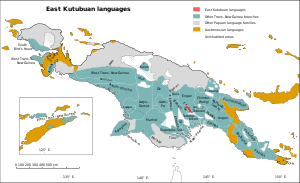East Kutubuan languages
In today's world, East Kutubuan languages has become a topic of great relevance and interest to a wide spectrum of society. Both on a personal and professional level, East Kutubuan languages has sparked numerous debates and discussions about its implications and consequences. From its origins to the present day, East Kutubuan languages has made a significant impact on the way we perceive the world around us. Over the years, East Kutubuan languages has evolved and adapted to the changes and challenges of the environment, demonstrating its ability to remain relevant and current in a world in constant transformation. In this article, we will explore in detail the multiple aspects and dimensions of East Kutubuan languages, analyzing its influence in different areas of life and its role in shaping the present and the future.
| East Kutubuan | |
|---|---|
| East Kutubu | |
| Geographic distribution | New Guinea |
| Linguistic classification | Papuan Gulf ?
|
| Subdivisions | |
| Glottolog | east2499 |
 Map: The East Kutubuan languages of New Guinea
The East Kutubuan languages
Trans–New Guinea languages
Other Papuan languages
Austronesian languages
Uninhabited | |
The East Kutubuan languages are a small family of Trans–New Guinea languages (TNG) in the classification of Malcolm Ross. There are just two languages,
which are not close to the West Kutubuan languages. These were linked in a "Kutubuan" family by Franklin and Voorhoeve in 1973, but there is some debate over whether they are closer to each other than to other Kikorian languages. Although East Kutubuan has proto-TNG vocabulary, Ross considers its inclusion in TNG to be questionable.
References
- Ross, Malcolm (2005). "Pronouns as a preliminary diagnostic for grouping Papuan languages". In Andrew Pawley; Robert Attenborough; Robin Hide; Jack Golson (eds.). Papuan pasts: cultural, linguistic and biological histories of Papuan-speaking peoples. Canberra: Pacific Linguistics. pp. 15–66. ISBN 0858835622. OCLC 67292782.